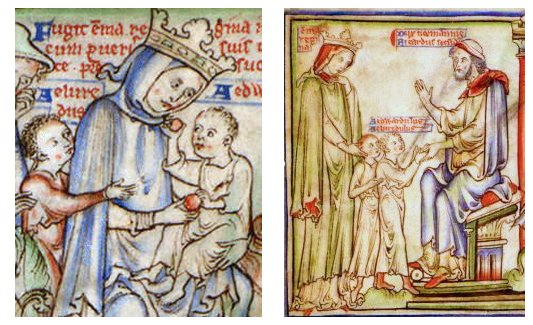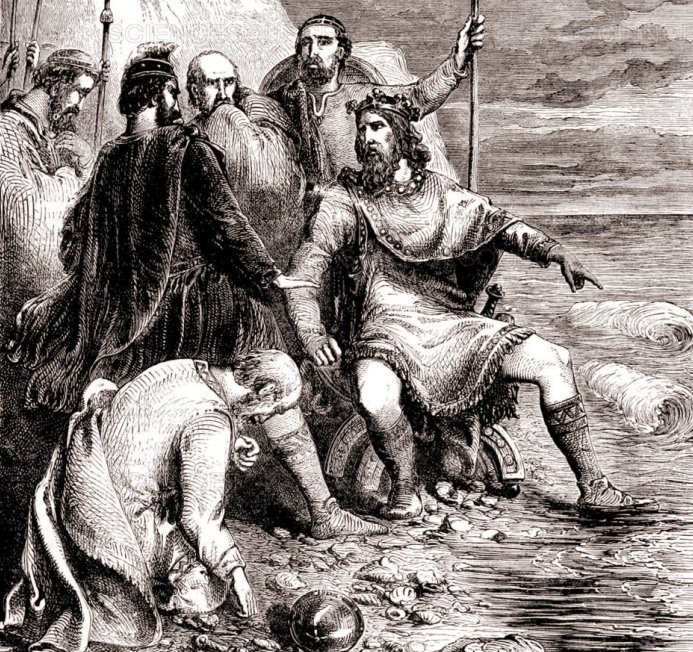How Emma Of Normandy Risked Her Life To Save England
Ellen Lloyd - AncientPages.com - Emma of Normandy is one of the most intriguing Medieval queens who pushed England into a new era, and yet, she is today largely forgotten.
Who was this strong-minded woman determined to stay in England and change the course of history despite fearing for her life?
The year was 1016, and Queen Emma's husband, Aethelred the Unready, had just died, leaving her a widow. Queen Emma knew the Vikings had conquered the country, and her life was in danger.
Being intelligent, Emma comes up with the idea that she might save herself, her children, and England. She will use her female charm and seduce Cnut The Great, but will the Viking King be attracted to her?
Who Was Emma Of Normandy?
Born in 984 in Normandy, France, Emma was the daughter of Richard I of Normandy and Gunnor, a Danish lady. Viking blood was running through Emma's veins because her great-grandfather was Rollo, the Viking sea Lord, chieftain, and Normandy's first ruler. Whether Roll was a Dane or Norwegian is still debated, but his historical importance in the history of Normandy cannot be questioned.
Emma lived when Vikings frequently launched attacks on England from Normandy. Despite having Viking ancestry, Emma was regarded as a Norman.
When she was 16 years old (according to some sources, 20 years), she was taken to the shores of Normandy, placed on a boat, and sent to England.
Aethelred in an early thirteenth-century copy of the Abingdon Chronicle. Credit: Public Domain
We can only guess what she felt and thought at the time, but we know she will marry King Aethelred II (Ethelred) of England. Her marriage to the 20-year-old King was arranged to ensure peace between England and Normandie and unite the countries against the Viking threat.
It's doubtful this was a happy marriage from the start. Emma was a young woman in a foreign country, and her husband had already fathered ten children. King Aethelred II was a tired man, constantly on guard, and the Viking raids on his lands seemed never-ending.
In any case, Emma was given the name Aelfgifu by the Anglo-Saxons. She and King Aethelred II had three children together, two sons and a daughter.
The English population did not have a high opinion of King Aethelred II, so he earned the nickname Ethelred the Unready. He was seen as a weak, cowardly monarch who could not defend his country correctly.
More and more Vikings invaded England, and they married Anglo-Saxons. The English population diminished, and the number of Danes in England multiplied.
The English King had to pay taxes to the Vikings, a requirement according to the Danelaw.
King Aethelred II And The Danish Massacre On St Brice's Day
Emma could not understand how her husband, the English King, allowed the Danes to take over his kingdom. Aethelred II understood he must prove himself to his wife and regain the respect of his people, but what could he do?
Being desperate, King Aethelred II announced a massacre of the Danes living on English soil. On St Brice's Day, November 13, 1002, people could hear the yelling - Kill all Danes! The King's troops carried out a massacre of the Danes, but something unexpected happened.
Left: Emma fleeing England with her two young sons following the invasion by Sweyn Forkbeard (1013). Detail of a 13th-century miniature. Credit: Public Domain - Right: Queen Emma and her sons being received by Duke Richard II of Normandy (Cambridge University Library). Credit: Public Domain
One of the victims was the sister of the Viking King, Sweyn Forkbeard of Denmark. Forkbeard was furious when he learned the English King had murdered his beloved sister, so he demanded revenge.
The following year, his Viking army plundered Emma's city of Exeter, among other places.
Many of the city's inhabitants were killed, and the survivors then blamed the massacre on Emma. They believed she had given her governor in the city orders to let the Vikings in through the city gate. Rumors flourished for several years, and Emma learned to be more careful about who she appointed to important positions." 1
King Aethelred II And Emma Queen Of England - Forced To Leave The Country
King Aethelred II did not accomplish much with his massacre of the Danes. On the contrary, Vikings intensified their attacks on England, and Emma and her children were forced to leave the country and take refuge in Normandy. Her husband followed shortly afterward, and they remained in France until the death of Sweyn in 1014.
This event allowed the King and Queen of England to return to their kingdom. However, their luck was not meant to last. Just two years after their return, King Aethelred II died in 1016, and Emma faced what seemed like a hopeless situation. On the shores of England, there were more Viking ships, but now it was Cnut the Great, the son of Sweyn Forkbeard, who was in charge of the invasion of England.
Emma's Controversial Marriage To Cnut The Great
Emma was alone and out of options. Meanwhile, Edmund Ironside, the eldest surviving son of her husband from his first marriage, was doing his best to defend England, but could his troops resist the mighty Viking army?
To Emma, the situation was complicated and dangerous. Her sons would be in mortal danger due to the right to inherit the throne. It didn't matter whether Edmund Ironside or Cnut the Great won the war.
Cnut reproving the flattery of his courtiers. Cnut the Great (995 - November 12, 1035) was King of Denmark, England, and Norway; often referred to as the North Sea Empire. source
Emma decided to send her 12-year-old son to fight with Ironside's army. If Ironside wins, she and her children will be left in peace, and they won't have to fear for their lives.
Then, something strange happened. On November 30, 1016, Edmund Ironside died, and the circumstances of his death were at least strange. Did he die on the battlefield, or was he murdered?
With Edmund Ironside gone, Cnut the Great becomes King of England, and Emma knows she must make a tough decision. The most logical thing to do would be to return to Normandy as quickly as possible. Cnut the Great had already executed many people who opposed him as the new King of England.
However, Emma decides to stay in England and find out if she can do something that can help to spare her children's lives and save England.
When Emma and Cnut the Great meet, she explains that she can help reassure the population if he agrees to marry her. The Viking is fully aware of how hated he is among the English people and finds the marriage proposal benefits society in general. Emma and Cnut the Great married, working hard to bring the Anglo-Saxons and Danes together. They had together a son, Harthacanute, and a daughter, Gunnhild.
Not all approved of their marriage, though. Emma was 32 years old when she married Cnut the Great, who was 21 years old. An angry poet in Normandy commended this union by writing: Which prostitute in the whole world would behave more degradingly?
Regardless of the evil talk behind their backs, Emma and Cnut the Great opened a new chapter in the history of England, and Cnut the Great, England’s Danish King, became the ruler of one of the largest Nordic empires.
Emma of Normandy is not as famous as Queen Elizabeth I, Mary Queen of Scots, Elizabeth Woodville, or Eleanor Of Aquitaine, to mention a few. Still, she does hold an important place in the history of England.
Let us not forget Emma of Normandy, who dared to risk her life to save England despite being a foreigner!
Emma of Normandy died on March 6, 1052.
Updated on December 9, 2023
Written by Ellen Lloyd – AncientPages.com
Copyright © AncientPages.com All rights reserved. This material may not be published, broadcast, rewritten or redistributed in whole or part without the express written permission of AncientPages.com
Expand for referencesMore From Ancient Pages
-
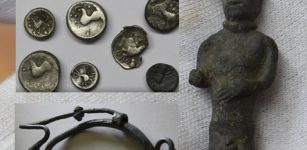 Bronze Celtic Figurine Of Man With Golden Eyes Found In Slovakia
Archaeology | Dec 12, 2020
Bronze Celtic Figurine Of Man With Golden Eyes Found In Slovakia
Archaeology | Dec 12, 2020 -
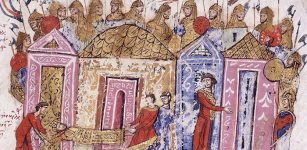 Nova Anglia: The Anglo-Saxon New England In The East
History | Jun 13, 2022
Nova Anglia: The Anglo-Saxon New England In The East
History | Jun 13, 2022 -
 Dwarf Alvis (‘All-Wise’) Who Was Tricked By God Thor And Turned Into Stone
Featured Stories | May 27, 2019
Dwarf Alvis (‘All-Wise’) Who Was Tricked By God Thor And Turned Into Stone
Featured Stories | May 27, 2019 -
 Grutte Pier – Legendary Giant Frisian Freedom Fighter Who Sought Revenge
Featured Stories | Dec 20, 2018
Grutte Pier – Legendary Giant Frisian Freedom Fighter Who Sought Revenge
Featured Stories | Dec 20, 2018 -
 Torquetum: Sophisticated Medieval Astronomical Instrument
Ancient History Facts | Jul 12, 2018
Torquetum: Sophisticated Medieval Astronomical Instrument
Ancient History Facts | Jul 12, 2018 -
 Rare Trove Of Ancient Metal Objects Unearthed In Mississippi Was Left By The Spaniards When The Chickasaws Attacked
Archaeology | Jul 2, 2021
Rare Trove Of Ancient Metal Objects Unearthed In Mississippi Was Left By The Spaniards When The Chickasaws Attacked
Archaeology | Jul 2, 2021 -
 Thousands Unknown Ancient Structures Seen From Space: Puzzling Aerial Archaeology In The Middle East
News | Feb 15, 2014
Thousands Unknown Ancient Structures Seen From Space: Puzzling Aerial Archaeology In The Middle East
News | Feb 15, 2014 -
 Dismantled Ancient Stone Circle In West Wales Was Used To Rebuilt As Stonehenge
Archaeology | Feb 13, 2021
Dismantled Ancient Stone Circle In West Wales Was Used To Rebuilt As Stonehenge
Archaeology | Feb 13, 2021 -
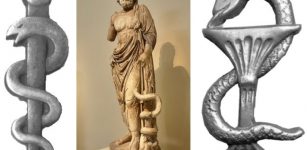 Why Is A Snake Symbol Of Medicine And Pharmacies?
Ancient History Facts | Jan 15, 2018
Why Is A Snake Symbol Of Medicine And Pharmacies?
Ancient History Facts | Jan 15, 2018 -
 Two-Million-Year-Old DNA Opens A ‘Game-Changing’ New Chapter In The History Of Evolution
Archaeology | Dec 7, 2022
Two-Million-Year-Old DNA Opens A ‘Game-Changing’ New Chapter In The History Of Evolution
Archaeology | Dec 7, 2022 -
 10 Mysterious Ancient Manuscripts With Hidden Secrets
Featured Stories | May 27, 2016
10 Mysterious Ancient Manuscripts With Hidden Secrets
Featured Stories | May 27, 2016 -
 4000-Year-Old Large Bronze Age Cemetery Discovered In Lower Silesia, Poland
Civilizations | Sep 21, 2015
4000-Year-Old Large Bronze Age Cemetery Discovered In Lower Silesia, Poland
Civilizations | Sep 21, 2015 -
 Fire-Burning Event At The Maya Kingdom Of K’anwitznal Was A Reaction To Regime Change
News | Apr 19, 2024
Fire-Burning Event At The Maya Kingdom Of K’anwitznal Was A Reaction To Regime Change
News | Apr 19, 2024 -
 Ötzi The Iceman’s Stomach Bacteria And Complex History Of European Settlements
Archaeology | Jan 8, 2016
Ötzi The Iceman’s Stomach Bacteria And Complex History Of European Settlements
Archaeology | Jan 8, 2016 -
 Exceptional Collection Of Well-Preserved Stucco Masks Of The Mayan Kingdom Reveal Their Secrets
Archaeology | Dec 5, 2022
Exceptional Collection Of Well-Preserved Stucco Masks Of The Mayan Kingdom Reveal Their Secrets
Archaeology | Dec 5, 2022 -
 Mystery Of The Delphi Oracle Prophecies: Was Pythia On Drugs While Guiding Ancient Greek Civilization For Thousands Of Years?
Civilizations | Nov 3, 2016
Mystery Of The Delphi Oracle Prophecies: Was Pythia On Drugs While Guiding Ancient Greek Civilization For Thousands Of Years?
Civilizations | Nov 3, 2016 -
 Unique Wooden Stave Churches Were Built Without Nails – Remarkable Technology Helped Them Survive
Featured Stories | Nov 15, 2022
Unique Wooden Stave Churches Were Built Without Nails – Remarkable Technology Helped Them Survive
Featured Stories | Nov 15, 2022 -
 Strange Ancient Accounts Of Fourth Dimensional Phenomena
Ancient Mysteries | Jun 7, 2018
Strange Ancient Accounts Of Fourth Dimensional Phenomena
Ancient Mysteries | Jun 7, 2018 -
 Eastern Necropolis Of Ancient Thracian And Roman City Of Serdica – Unearthed
Archaeology | Apr 10, 2017
Eastern Necropolis Of Ancient Thracian And Roman City Of Serdica – Unearthed
Archaeology | Apr 10, 2017 -
 Urban Resiliency Lie Within Ancient Cities – New Study Suggests
Archaeology | Jul 25, 2023
Urban Resiliency Lie Within Ancient Cities – New Study Suggests
Archaeology | Jul 25, 2023



